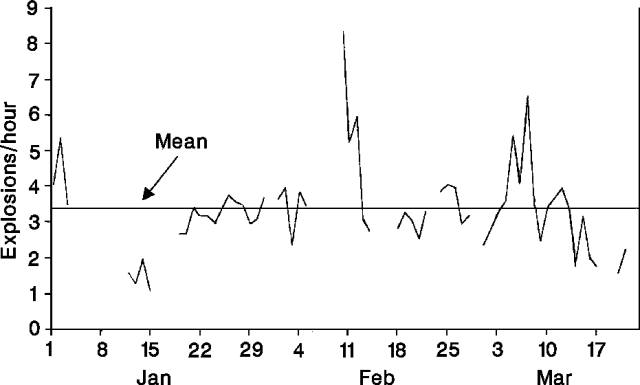Report on Stromboli (Italy) — April 1991
Bulletin of the Global Volcanism Network, vol. 16, no. 4 (April 1991)
Managing Editor: Lindsay McClelland.
Stromboli (Italy) Explosive activity from a single crater; strong seismicity
Please cite this report as:
Global Volcanism Program, 1991. Report on Stromboli (Italy) (McClelland, L., ed.). Bulletin of the Global Volcanism Network, 16:4. Smithsonian Institution. https://doi.org/10.5479/si.GVP.BGVN199104-211040
Stromboli
Italy
38.789°N, 15.213°E; summit elev. 924 m
All times are local (unless otherwise noted)
Explosive activity was at low levels from January through March, seldom exceeding the long-term average of six recorded explosions/hour (figure 11). Visits to the summit on 30 March and 9 April revealed that activity was restricted to Crater 1, and that the small cone 1 in Crater 3 had collapsed, forming a glowing red vent. The number of earthquakes exceeding instrument saturation level was quite high from the end of January to the beginning of February (~30/day), and 11-17 March (~19/day; figure 12). Average tremor amplitude returned to normal following a low in December.
 |
Figure 11. Daily average number of seismically recorded explosion events/hour at Stromboli, January-March 1991. The mean value for the period is shown. Courtesy of M. Riuscetti. |
 |
Figure 12. Number of seismometer-saturating events/day (upper curve); and average tremor amplitude (lower curve) at Stromboli, January-March 1991. Courtesy of M. Riuscetti. |
Geological Summary. Spectacular incandescent nighttime explosions at Stromboli have long attracted visitors to the "Lighthouse of the Mediterranean" in the NE Aeolian Islands. This volcano has lent its name to the frequent mild explosive activity that has characterized its eruptions throughout much of historical time. The small island is the emergent summit of a volcano that grew in two main eruptive cycles, the last of which formed the western portion of the island. The Neostromboli eruptive period took place between about 13,000 and 5,000 years ago. The active summit vents are located at the head of the Sciara del Fuoco, a prominent scarp that formed about 5,000 years ago due to a series of slope failures which extends to below sea level. The modern volcano has been constructed within this scarp, which funnels pyroclastic ejecta and lava flows to the NW. Essentially continuous mild Strombolian explosions, sometimes accompanied by lava flows, have been recorded for more than a millennium.
Information Contacts: M. Riuscetti, Univ di Udine.

